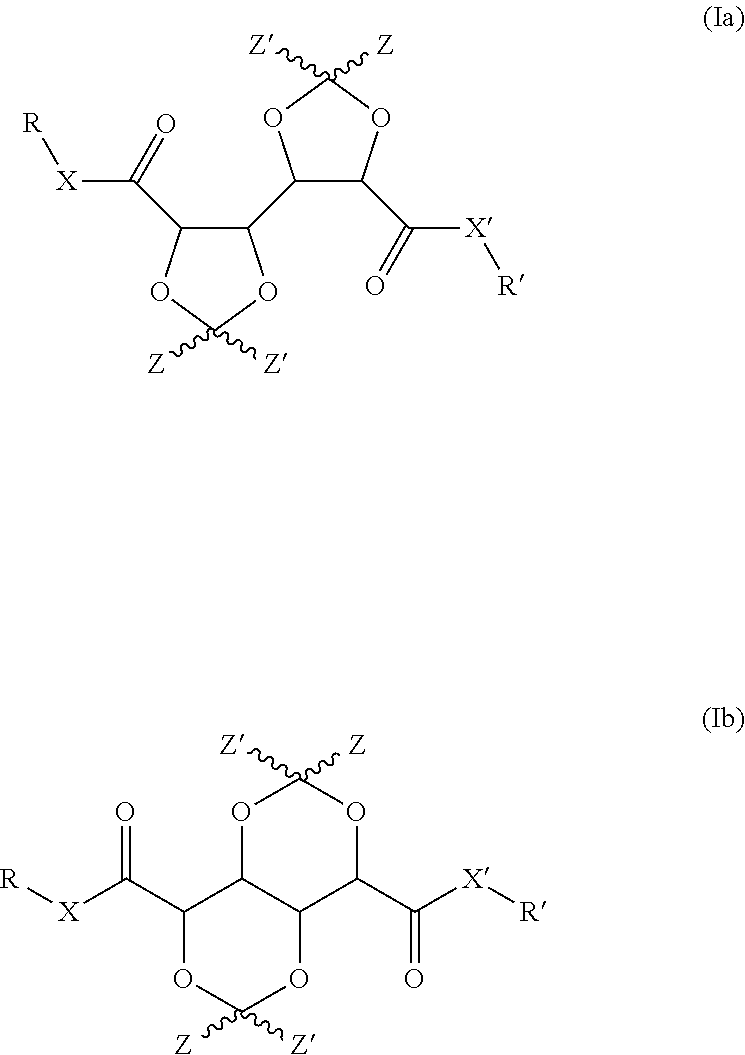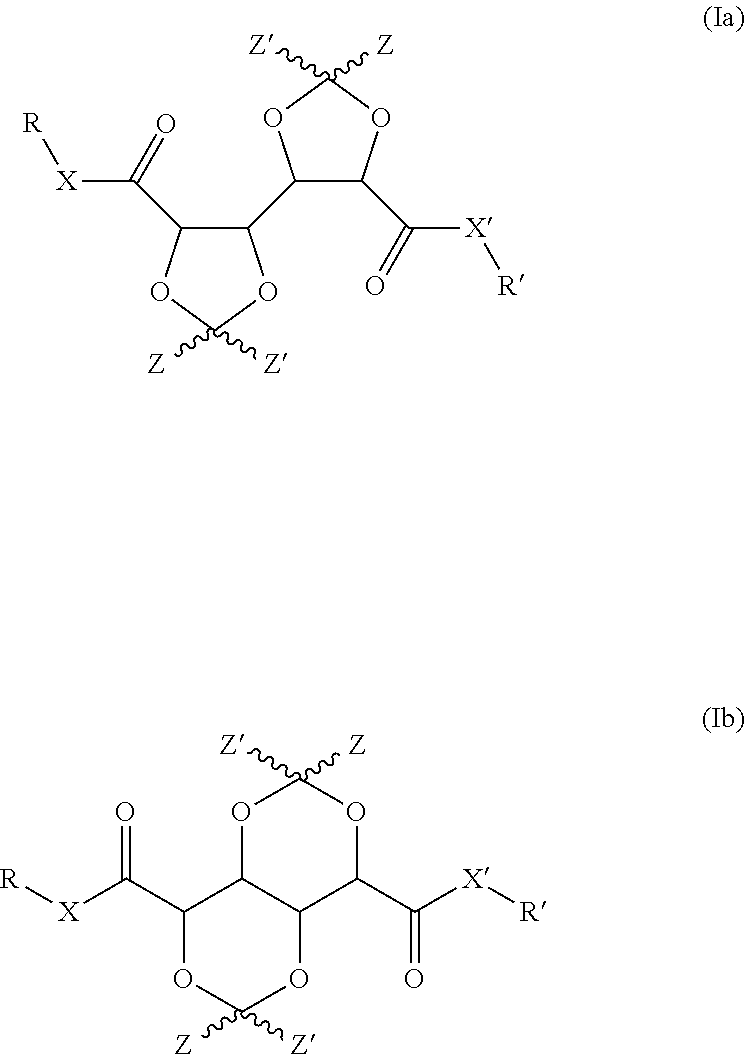Bis-diox(OL)ane compounds
a technology of bisdiox and ane compounds, applied in the field of new bifunctional and polyfunctional bisdiox (ol) ane compounds, can solve the problems of difficult synthesis of bi- and polyfunctional monomers, and achieve the effects of high efficiency, high flexibility, and facilitate the introduction of desired functionality
- Summary
- Abstract
- Description
- Claims
- Application Information
AI Technical Summary
Benefits of technology
Problems solved by technology
Method used
Image
Examples
example 1
Synthesis of GalX-allylester
[0084]Sodium methoxide (0.16 g, 2.9 mmol) was added to a solution of GalX (20.0 gram, 57.8 mmol, obtained following procedures described in literature, allyl alcohol (250 mL). The solution was refluxed for 5 days. After cooling down and evaporation, the solid material was stirred in heptane and filtrated to remove the salts. The product was isolated after evaporation of heptanes, followed by crystallization from ethanol and water, filtrated and dried in a vacuum oven.
[0085]Product GalX-allylester (Mw 370): 15.4 gram (yield 72%). HPLC: 99% pure material. 1H NMR (400.17 MHz, CDCl3): δ (ppm)=5.92 (m, 2H); 5.36 (dd,2JHH=17.2 Hz, 3JHH=1.4 Hz, 2H); 5.27 (dd,2JHH=10.4 Hz, 3JHH=1.2 Hz, 2H); 4.69 (d,3JHH=5.85 Hz , 4H); 4.62 (dd, 2JHH=4.3 Hz, 3JHH=1.3 Hz, 2H); 4.49 (dd, 2JHH=4.2 Hz, 3JHH=1.3 Hz, 2H); 1.49 (s, 6H); 1.44 (s, 6H). 13C NMR (100.62 MHz, CDCl3): δ (ppm)=170.74 (C═O); 131.45 (CH2═CH); 119.30 (CH2═CH); 112.53 (C(CH3)2); 79.28 (CHCH); 76.13 (C═OCHCH); 66.22...
example 2
Synthesis of GalX-diepoxyester
[0086]mCPBA (35.8 g, 208 mmol) was added to a solution of GalXallylester (11 gram, 29.7 mmol) in DCM (250 mL). The solution was stirred for 60 hours at reflux temperature. After cooling down, the solution was filtrated. The filtrate was washed with Na2SO3, Na2CO3 and water. The organic phase was evaporated to dryness. Product GalX-diepoxyester crude (Mw 402): 8.8 gram (yield 74%). HPLC: 99% pure material. 1H NMR (400.17 MHz, CDCl3): δ (ppm)=4.61 (d,3JHH=4.4 Hz, 2H); 4.50 (dt, 2JHH=12.2 Hz, 3JHH=2.5 Hz, 2H); 4.46 (dd, 2JHH=4.4 Hz, 3JHH=1.3 Hz, 2H); 4.04 (ddd, 2JHH=12.2 Hz, 3JHH=6.2 Hz, 4JHH=1.1 Hz, 2H); 3.20 (m, 2H); 2.81 (t, 2JHH=4.8 Hz, 2H); 2.64 (dd, 2JHH=4.9 Hz, 3JHH=2.5 Hz, 2H); 1.47 (s, 6H); 1.42 (s, 6H). 13C NMR (100.62 MHz, CDCl3): δ (ppm)=170.79 (C═O); 112.53 (C(CH3)2); 79.28 (CHCH); 76.13 (C═OCHCH); 65.90 (CH2OC═O); 49.02 (CHO); 44.62 (CH2O); 27.15 (CCH3); 26.12 (CCH3).
MwDensityQuantityQuantityQuantityeqCompound(g / mol)(g / ml)(g)(ml)(mmol)1GalXal...
example 3
Synthesis of GalX-allylamide
[0087]Allylamine (g, 30.3 mmol) was added to a solution of GalX (5 gram, 14.5 mmol) in MeOH (50 mL). The solution was stirred for 1 night at room temperature. After evaporation of the solvent, 50 mL of ethyl acetate was added and the solution was refluxed overnight. After cooling down and evaporation, the solid material was crystallized from ethanol and water, filtrated and dried in a vacuum oven.
[0088]Product GalX-allylamide (Mw 368): 3.1 gram (yield 58%). HPLC: 99% pure material. 1H NMR (400.17 MHz, CDCl3): δ (ppm)=6.74 (s,2H); 5.83 (m,2H); 5.21 (dd,2JHH=17.2 Hz, 3JHH=1.4 Hz, 2H); 5.15 (dd,2JHH=10.2 Hz, 3JHH=1.2 Hz, 2H); 4.79 (d, 2JHH=7.0 Hz, 2H); 4.53 (d, 2JHH=7.1 Hz, 2H); 3.91 (m, 4 H), 1.51 (s, 6 H), 1.44 (s, 6H). 13C NMR (100.62 MHz, CDCl3): δ (ppm)=170.72 (C═O); 133.82 (CH2═CH); 116.69 (CH2═CH); 110.89 (C(CH3)2); δ 78.76 (CHCH); 75.01 (C═OCHCH); δ 41.35 (CH2NHC═O); 26.82 (CCH3); 26.11 (CCH3).
MwDensityQuantityQuantityQuantityeqCompound(g / mol)(g / ml)(...
PUM
| Property | Measurement | Unit |
|---|---|---|
| temperatures | aaaaa | aaaaa |
| temperatures | aaaaa | aaaaa |
| temperatures | aaaaa | aaaaa |
Abstract
Description
Claims
Application Information
 Login to View More
Login to View More - R&D
- Intellectual Property
- Life Sciences
- Materials
- Tech Scout
- Unparalleled Data Quality
- Higher Quality Content
- 60% Fewer Hallucinations
Browse by: Latest US Patents, China's latest patents, Technical Efficacy Thesaurus, Application Domain, Technology Topic, Popular Technical Reports.
© 2025 PatSnap. All rights reserved.Legal|Privacy policy|Modern Slavery Act Transparency Statement|Sitemap|About US| Contact US: help@patsnap.com



